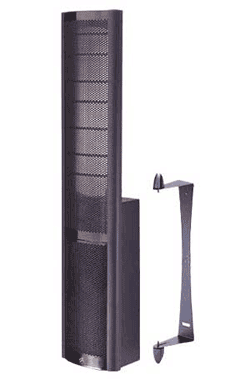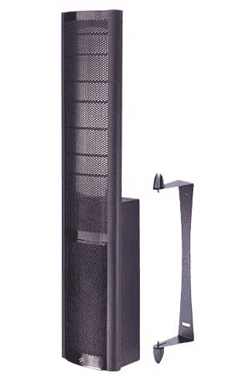


One of the minor dilemmas associated with audio reviewing is the need to keep a number of systems on the go. It's necessary if one cares enough to review products in context: you need to use high-end partnering components for costly gear, mid-price for mid-price and so on. With A/V, you have to multiply things by five...especially speakers. I thought I had it down pat, price-wise, with the reference system I've been using - three Apogee LCRs across the front and two Apogee Ribbon Monitors (LCRs minus one woofer) at the back - because the price was smack in the middle. But then I was reminded at the Hi-Fi Show of their 'unsuitability': they're no longer available, and readers don't want reviews written with obsolete ancillaries.
Additional Resources
• Read more floorstanding speaker reviews from HomeTheaterReview.com.
• Find a receiver to integrate with the MartinLogan speakers.
This created a problem because the Apogees were ideally suited to represent the median level between the rotgut dreck which passes for 'home theatre' (all-in for £699-type swill, or, worse, what comes with a TV) and the Trump-ian extreme represented by wealthy enthusiasts who can dial up a CEDIA member and say, 'Build me a home cinema but keep it under £500,000.' With no apologies whatsoever, I price the minimum decent home theatre, minus the cost of a monitor or projector and suitable for audiophiles as well as normal people, at around £5000-£7500: £500 for a DVD player, £1500-£2000 for one of the better A/V receivers and £3000-£5000 for five matched speakers.
With a bottom-level price of only £600 per speaker/channel, we are not talking about Wilson or Revel or ATC but the kind of speakers which ordinary people can afford. So (believing that I had been a good boy all these years by using sensible, affordable boxes for my A/V system), all I could hear were the moans of the penny-pinchers - those who wouldn't dream of buying anything better than 'Home Theatre In A Six-Pack' garbage even if they had the money - when I was told that I had to assess a complete Martin-Logan set-up. But when I found out that the total package came to £4684, I could only rub my hands with glee. Under £5k for five electrostatics - if you think that's too much then you kiss my psoriatic ass.
Admittedly, I was shocked when the system arrived and the fronts and rears were not the same, having asked specifically that all four be identical and that they be the least expensive models in the M-L line-up. I needn't have worried, though, because the price difference between a pair of Scenarios and a pair of Scripts was only £91. Furthermore, the Script and the Scenario share identical electrostatic panels, so they sound exactly the same above the bass region, the Scenario enjoying, for the extra £91, slightly larger woofers.
Here's how the system breaks down into its constituent parts:
At the centre is the Cinema (£1395), a hybrid which departs from Martin-Logan practice in that the electrostatic element doesn't cover the uppermost frequencies, only the midband. Its elegant, curved enclosure contains a shielded 5.25in woofer at either end, each in its own sealed cabinet. In-between and curving inward is a slice of a CLS electrostatic element, this horizontal, concave strip covering the midband. The crossover point between it and the woofers is 300Hz (12dB/octave), while at 3500Hz, the electrostatic element crosses over with the same slope to a vacuum-formed, 1in soft-dome tweeter. The dome was chosen for its dispersion characteristics, a centre channel speaker requiring a broad sweep with carefully defined horizontal and vertical dispersion voiced for, primarily, what are dialogue duties.
M-L thought very carefully about this design in industrial as well as sonic terms, a speaker which is - remarkably - only slightly larger than the 'norm' amongs conventional centre-channel systems at 860x260x200mm (WDH). To facilitate both its size and its non-cubist form, the company also offers a bracket, allowing it to be wall- or floor-mounted and tilted over a wide arc to direct the sound at the listener. I have my monitor and system on a large, open-shelf unit, so I positioned the Cinema on the top shelf, aimed downward at a 20 degree angle, without having to resort to the swivel bracket; the rear of the speaker rested in the shelving unit's uprights. It is, by the way, the prettiest centre-channel speaker I've ever seen, the unit sporting the see-through sections which are this make's stylistic trademark.
For front left-and-right duties, the company supplied a pair of Scenarios (£1690 per pair), compact floor-standers measuring only 1190x254x381mm (HWD). The footprint accommodates a conventional woofer housing which extends only 660mm upward, so you still get that wonderful see-through effect - like the Cinema - for the speaker's upper half, the primary visual element which makes Martin-Logans so beloved of wives, decorators and the cast of Friends. The electrostatic panel covers 500Hz-22kHz, the 8in high-excursion cone woofer dealing with 45-500Hz. Martin-Logan states that the dispersion of the system is 30 degrees horizontal and with the vertical being a 23in line source. Whatever the maths, this speaker ensured that there were no gaps between it and the Cinema - most impressive on left/right sweeps. Both the Scenario and the Cinema offer 89dB/1W sensitivity and nominal impedance of 6 ohms (1.5 ohm minimum @ 20kHz for the Scenario, 3.7 ohms for the Cinema), so - slight impedance variation aside - it presented a near-ideal situation for the three-channel Acurus 200X3 power amplifier I used across the front.
Read more about the MartinLogan speakers on Page 2.
At the back, driven by another Acurus, were the Scripts ( 1599 per
pair), which look like what they are: baby Scenarios. The Script stands
1075x254x200mm (HWD), the unit supplied with a plinth on which it can
swivel, while an optional wall-mounting bracket also allows the speaker
to swivel up to 175 degrees. I can understand it with a wall bracket,
but quite why you'd need to make it so it can swivel it on its floor
stand, when the thing is so tiny and weighs a mere 27lb, I don't know.
Maybe some people are too lazy to move the unit-plus-plinth. Daft:
we're not exactly talking about re-positioning a pair of WATT/Puppies
on spikes...
In the Script, the electrostatic element works above 700Hz; below it
is a 6.5in cone woofer operating down to 70Hz. Slightly less sensitive
than the Scenario, the Script specs out at 88dB/1W, with a 4 ohm
impedance (worst case: 2 ohms @ 20kHz). All of the 'Logans feature
oversized screw terminals - CE-approved by virtue of their plastic
grips - and were supplied in all-black finish. For an extra 200, you
can order the Scripts in white.
As these are electrostatics, you'll need five spare AC outlets; I
hooked 'em up for a couple of days before doing any serious listening,
and I leave them on at all times. Run-in seemed to last about a week,
but they kept on improving for the first month before settling down to
a level of performance I can only describe as jeans-tightening. This
little 'Logan package is something to behold...
Using the aforementioned amps, the Lexicon MC-1 processor, and the
Pioneer DV-414 (Region 1) and DVL-909E (Region 2) DVD players, I
ploughed through more films in a given period than I have ever been
tempted to do before...and not just because I'm addicted to amazon.com
and had so many new films to devour. Quite blatantly, the sound was so
ideally-voiced to A/V usage that I found the entire experience to be
something new Hell, I even watched familiar films again, stuff like
Armageddon, of which I'd had my fill at hi-fi shows. I even sat through
another run of the gawdawful Austin Powers: International Man Of
Mystery, because my son's glee was irresistible. Any fears that I had
become jaded were instantly dispelled: the 'Logan quintet made movies
even more fun.
Here's how it played out at the Kessler Rialto:
Whatever it is that electrostatics possess, and I am the first to
declare his love for the original Quad ESL because of their silkiness,
I never expected any electrostatics to be so apt, so well-suited for
A/V use. OK, so I had toyed many times with the thought of finding
another three Quads to make up my own dream 5-channel system, but space
kept me from making the move. The 'Logans provided five channels of
electrostatic bliss (admittedly, with cones down below) in slightly
less space than I'd previously allocated to the similarly slim and
compact Apogees. And while my wife didn't exactly register a favourable
response to the replacement of five black boxes with five elegant
quasi-panels, she did seem somehow happier with the new look.
It's all about atmospherics. Given that the main speakers, when fed
audio-only signals via CD, proved to be classically 'Martin-Logan' -
delicate, transparent, refined, eminently free of fatigue-inducing
artefacts - they passed the first test with ease: You can live with
these for two-channel-only purist pursuits without fear of compromise.
Low coloration, sweet upper frequencies, no cabinet resonances - better
still, the woofer sections, despite the single-cone-per-enclosure
complement, provided enough weight and power to serve the needs even of
Classic's 96/24 discs, MoFi's latest Guns'n'Roses CD and a flood of
recent Cuban exploitation discs. But this is the A/V section, and I was
not expecting the 'Logans to survive Stallonification.
It might have been The Fifth Element's final 15 minutes, or the DTS
version of The Shadow. Both possessed two, er, elements which, while
meaningless with music, separate the Cohibas from the Silk Cuts when
you're watching films. They are rapid explosions and/or gunfire, allied
to sweeps across the room, either diagonal or straight front-to-back.
Seamless dimensional transitions accomplished to perfection while
retaining both the transient impact and the bass extension? A tough
call by any measure, if a doddle for behemoths armed with, say, a brace
of 12in cone woofers per enclosure and a kilowatt or two in total juice
complement. I used nothing like that to drive the 'Logans, I eschewed a
subwoofer, and yet I never - NEVER! - felt any loss of low-frequency
information nor direction coherence. Just play the section of The
Shadow, at the beginning where his voice flies around the room while
tormenting the hoodlums on the bridge. Creepy? You'll be looking over
your shoulder.
Equally as impressive was all this mass being partnered to upper
frequencies so delicate, so clean that even shouted dialogue in front
of a layer of noisy sound effects came through with coherence and
clarity. Much though I expected the dome tweeter fitted to the centre
of the Cinema to destroy the electrostatic illusion, it was not the
case. M-L's designers clearly voiced the dome to retain the necessary
lucidity required to convey dialogue, while ensuring that it matched
the tonal signature of the CLS-based elements. And why does the purist
in me not balk? Did someone say Kelly Ribbon Tweeter on top of a Quad
ESL?
Forget accusations about hybrids not working. Even with music-only
programme material, it was hard to say conclusively that you could hear
the crossover point, less so in the Scenario than the Script. Forget,
too, that the Cinema commandeered a dome tweeter to deal with centre
channel directional concerns. Instead, just revel in the knowledge that
not only can you enjoy your five channels with electrostatics, but also
for under a grand per channel. This is, for the foreseeable future, my
'real world' A/V reference system.
Additional Resources
• Read more floorstanding speaker reviews from HomeTheaterReview.com.
• Find a receiver to integrate with the MartinLogan speakers.